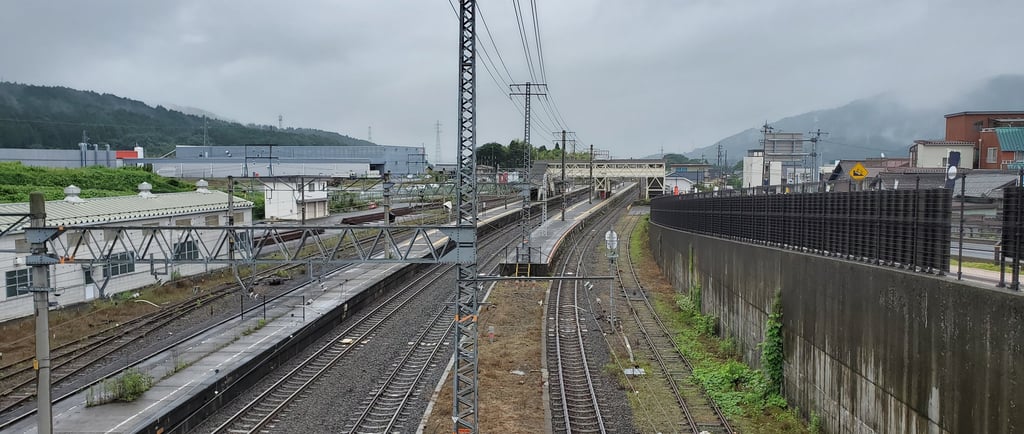Circles of Sekigahara
Our trip to Sekigahara was definitely a highlight of our adventures. It was emotional, educational, and led us to a sense of interconnectedness with Japan and its history. It was a sincere 10/10 — and whatever the cost, it was worth it. I would definitely recommend it to any wanderer who wants to understand Japan.
Travel tip
If traveling anywhere I suggest rather than trying to see an entire country in two weeks maybe focus on an area. Then you can really get to know the country and the people. And it gives you an excuse to go again. We did this on this trip and found we had little opportunity to get a feel for the area. It felt more like an Instagram moment than a chance to get to know the people
Leaving Sekigahara
We made our way back to the store to gather our luggage from the lockers and headed toward the train station. It wasn’t raining this time, but we kept our umbrellas out — you never know when a storm might come to rural Japan. We headed to the train platform to begin our next journey. Our next stop would be Kyoto, but to get there we’d need to catch another train. We were hoping to catch the 4:13 departure, and with a 59-minute ride and one transfer, we didn’t want to miss it. The trains ran every 30 minutes until 8:13, but the later the train, the later the arrival. We didn’t want to reach Kyoto and need to look for a hotel in the dark — especially with the possibility of more rain.
Finding the Platform
We headed for Sekigahara Station (関ケ原駅) to find the JR Tōkaidō Main Line, platform 2, for Maibara and then Kyoto. The platform wasn’t difficult to find — not like Nagoya. Nagoya Station has ten railway lines and nineteen platforms. That takes some thinking and patience to navigate. Or Google Maps. I like Google Maps.
The Station Between Worlds
I prefer the rural stations, like the one in Sekigahara. They often have an open roof, and at night you can see the stars. Birds flutter around, trying to steal crumbs from my konbini egg salad sandwich. And they have fewer tracks to get lost on. Sekigahara has two tracks and two platforms. I like simplicity. Signs are in both Japanese and English, and the next-departure screens clearly show the direction (米原・京都方面 = “for Maibara/Kyoto direction”). At Maibara Station (米原駅), we’ll need to transfer to the JR West Biwako Line. We won’t even need to get off the train — it simply changes operating companies. Same drivers, same train. I’m sure there’s a reason.
Reflections on the Journey
Today’s a travel day. There won't be many new discoveries aside from finding our hotel. But, the good thing is it gives me plenty of time to think. I’ve come to several conclusions on this trip. The first one is I believe that if I’m to understand where I am, I need to know how I got here. I think the same applies to cultures, peoples, and beliefs. Japan as an example; to understand how Japan came from a closed (politically and culturally) society and has risen to become the national powerhouse is important and after visiting the battlefield I came to understand how Japan has transitioned. The other thing I realized is that Japan exists as a loop in which everything connects. Walk through the torii gates of Kyoto’s Fushimi Inari Taisha, and you’re walking through centuries of memory. The torii gates were originally built in the 8th century with each gate donated by an individual or a business as an offering to the Hata clan. Also, the torii marks the transition from the mundane to the sacred. Passing through it means entering a purified space. At Fushimi Inari, thousands of these gates line the pathways up Mount Inari, symbolizing the gradual ascent from the ordinary world into the realm of the divine.
The Hata clan were immigrant weavers who prayed for harvests and prosperity. That’s why the shrine is dedicated to the Inari deity. Every one of the 5,000 steps along the trail to the shrine is a reminder of that dedication to achieve a result. The Tokugawa clan, who ruled Japan nearly a millennium later, never met the Hata, yet their world still pulsed with the Hata’s spiritual legacy. The rice, the trade, the quiet prosperity that flowed through Edo-era Japan — all owed something to those early shrine builders of Kyoto. The Hata prayed for the fertility of the land; the Tokugawa turned that abundance into stability. The roots of rice became the roots of order. Further north, the same cycle of transformation breathes in the mountains of Zaō, the home of the Fox Village. There, the fox is revered and protected because of it’s symbolism and kindness. In Kyoto the same reverence is shared by the construction of the shrine. Like the great Harry Chapin song, “Circles” is all about the inner connectivity of life. As the train passed Lake Biwa and the plains below Mount Ibuki, we relaxed and thought about tomorrow’s adventures. We planned to climb those steps to the Inari Shrine and walk the streets of Gion, old time Kyoto.
But, for now we had a transfer to make and then find our hotel.


